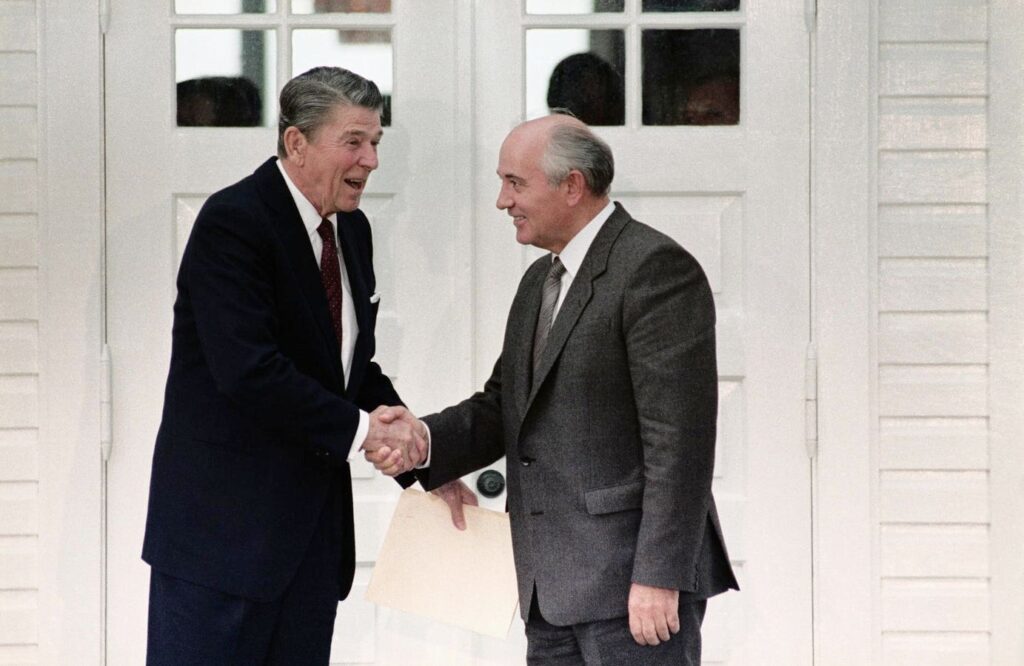T
Concluding a morning meeting, President Ronald Reagan and Soviet General Secretary Mikhail Gorbachev … More
The world is at one of its most dangerous points in recent memory. An unresolved war in Ukraine, military escalation in the Middle East, continuing civil war in Sudan, tensions between India and Pakistan, and a near collapse of the global nuclear arms control regime. Add to this internal conflicts at home that have led to the deployment of active duty Marines to put down demonstrations in Los Angeles and the murder of a prominent elected official in Minnesota, and one can be forgiven for feeling like the global situation is spinning out of control.
At this moment of peril, the last thing the world needs is a surge in spending on nuclear weapons, which, if used in significant quantities, can end life as we know it. But according to a new report by the International Campaign to Abolish Nuclear Weapons (ICAN), that is precisely what is happening.
Global spending on nuclear weapons topped $100 billion in 2024, the last year for which full statistics are available. The new figure was an 11% increase from 2023. More than half of world nuclear weapons spending – $56 billion – was accounted for by the United States.
The risks of piling up yet more nuclear weapons in a world that already has thousands of them are real, but so are the profits that flow from developing, building, and maintaining them. The ICAN report identified 26 companies that split $20 billion in contracts for nuclear systems in 2024, with a whopping $463 billion in outstanding contracts from deals made in past years.
But even as some nations double down on nuclear spending, there are signs of hope – 98 countries have signed, ratified or acceded to the Treaty of the Prohibition of Nuclear Weapons (TPNW), which bans all nuclear weapons activities and commits signatories to work towards their destruction.
The question is whether the publics of the nuclear weapons states – the United States, Russia, China, India, Pakistan, France, the United Kingdom, North Korea, and Israel – can persuade their governments to join the nuclear ban treaty, or at least reduce the size of their arsenals and agree to some rules of the road on crisis communications and agreeing not to strike first with their nuclear arsenals in a crisis.
The prospects for trimming nuclear arsenals and reducing the risk of a nuclear conflict seem daunting in the short-term, but history suggests that changes in nuclear policy can come about in relatively short order with adequate public pressure. A case in point is what happened during the Reagan administration. In a few short years, a staunchly anti-communist president who referred to the Soviet Union as the evil empire and joked that “the bombing starts in five minutes” had acknowledged that “a nuclear war can never be won and should never be fought” and set the stage for significant reductions in the size of U.S. and Soviet nuclear arsenals.
This shift was not due to some personal quirk or crisis of conscience on the part of Ronald Reagan, although some of his associates have reported that he had a visceral opposition to the idea of ever launching a nuclear weapon. But the main driver of the Reagan administration’s shift in nuclear policy was the U.S. anti-nuclear movement, symbolized by the nuclear freeze campaign and punctuated by a million person rally for disarmament in New York’s Central Park in June of 1982.
As the movement grew, aides to the president told him that the anti-nuclear movement had gone mainstream, and that if he wanted to survive politically he had to take action to convince the public that they were not at risk of dying in a nuclear holocaust. And so he did, both with the ill-fated Star Wars missile defense program and through serious dialogue on nuclear arms reductions with Soviet reformer Mikhail Gorbachev.
History rarely repeats itself precisely, but it is possible that the instability spanning the globe might, just might, prompt citizens and diplomats alike to seek measures to control and reduce global nuclear arsenals and take affirmative steps to reduce the risk of nuclear weapons use. But first there needs to be a warming of relations among the big nuclear powers – the U.S., Russia, and China. They don’t need to become best of friends, but they need to be clear-eyed about the fact that no one will win if the nuclear arms race spirals out of control, and that dialogue on how to control and reduce these potentially world-ending weapons is urgently necessary.
Read the full article here
